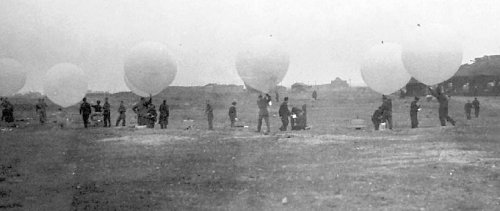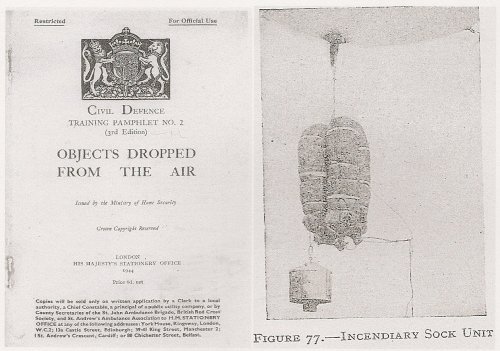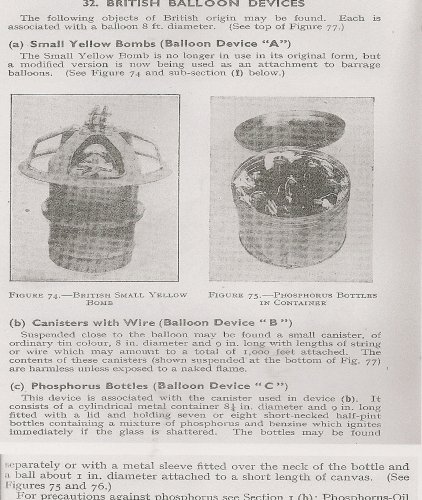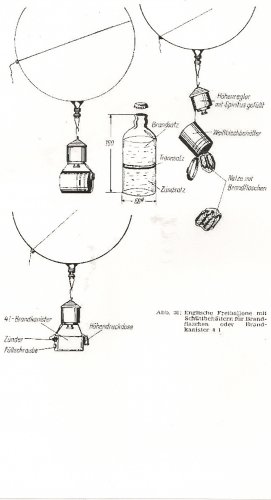W
Wingknut
Guest
I put this under 'Early Aircraft Projects' because the things were free-flying but sorry if they should be under 'Missiles'.
The sheer scale of this plan makes it hard to regard as a 'secret' project but seemingly it is, or at least I'd never heard of it. Anyway, here’s something on Britain’s 'Operation Outward' plan for offensive free-balloon operations, (something like the Japanese Fu-Go system but seemingly on a much bigger scale and often intended to foul power cables):
“Operation Outward was the name given to the British World War II program to attack Germany by means of free-flying balloons. It made use of cheap, simple balloons filled with hydrogen. They carried either a trailing steel wire intended to damage high voltage power lines by producing a short circuit, or incendiary devices that were intended to start fires in fields, forests and heathland.
A total of 99,142 Outward balloons were launched; about half carried incendiaries and half carried trailing wires.
Compared to Japan's better known fire balloons, Outward balloons were crude. They had to travel a much shorter distance so they flew at a lower altitude – 16,000 feet (4,900 m), compared with 38,000 feet (12,000 m) – and had only a simple mechanism to regulate altitude by means of dropping ballast or venting lifting gas. This meant the balloons were simple to mass-produce and only cost 35 shillings each (approximately equivalent to £86 in 2016).
The free flying balloon attacks were highly successful. Although difficult to assess exactly, they had an economic impact on Germany far in excess of the cost to the British government.”
https://en.wikipedia.org/wiki/Operation_Outward
“On 12 July 1942, a cable-trailing balloon struck a 110,000 volt power line near Leipzig. The overload switch in the nearby Bohlen power station did not trip quickly enough, resulting in a fire which spread and destroyed the entire complex. The damage was estimated at a million pounds, to be compared with the £ 220,000 spent on operation Outward.
Launches decreased progressively to avoid interference with the ever-increasing bombing campaign over Germany, and slowly came to a halt after D-Day, as Allied forces were advancing. The last launches were made on 4 September 1944.
Between March 1942 and September 1944, 99,142 balloons were produced and launched. Of these, 55,343 were of the incendiary type and 45,599 of the cable-trailing type.
While Operation Outward was of no significant military value per se, it can only be considered a great success in the scope of total war. During a period of 30 months, the balloons were a nuisance to the enemy and did cause actual damage. The cost of the whole program was negligible compared to what it cost the Axis. As such, it is surprising that such an operation has remained largely unknown to this day”,
Quoted from ‘Operation Outward’ by Gaëtan Marie, http://www.ghostgrey.gaetanmarie.com/articles/2008/outward/outward2.htm
See also: 'Operation Outward: Britain's World War II offensive balloons', by Raoul E. Drapeau, IEEE Power and Energy Magazine, September / October 2011
http://magazine.ieee-pes.org/september-october-2011/operation-outward/
Article in PDF at:
sites.ieee.org/ny-monitor/files/2011/09/OPERATION-OUTWARD.pdf
Pictures of Outward devices taken from Wikipedia (cited above) and from here:
http://www.whatliesbeneathrattlechainlagoon.org.uk/?attachment_id=770
http://www.whatliesbeneathrattlechainlagoon.org.uk/?attachment_id=771
http://www.whatliesbeneathrattlechainlagoon.org.uk/?attachment_id=773
The sheer scale of this plan makes it hard to regard as a 'secret' project but seemingly it is, or at least I'd never heard of it. Anyway, here’s something on Britain’s 'Operation Outward' plan for offensive free-balloon operations, (something like the Japanese Fu-Go system but seemingly on a much bigger scale and often intended to foul power cables):
“Operation Outward was the name given to the British World War II program to attack Germany by means of free-flying balloons. It made use of cheap, simple balloons filled with hydrogen. They carried either a trailing steel wire intended to damage high voltage power lines by producing a short circuit, or incendiary devices that were intended to start fires in fields, forests and heathland.
A total of 99,142 Outward balloons were launched; about half carried incendiaries and half carried trailing wires.
Compared to Japan's better known fire balloons, Outward balloons were crude. They had to travel a much shorter distance so they flew at a lower altitude – 16,000 feet (4,900 m), compared with 38,000 feet (12,000 m) – and had only a simple mechanism to regulate altitude by means of dropping ballast or venting lifting gas. This meant the balloons were simple to mass-produce and only cost 35 shillings each (approximately equivalent to £86 in 2016).
The free flying balloon attacks were highly successful. Although difficult to assess exactly, they had an economic impact on Germany far in excess of the cost to the British government.”
https://en.wikipedia.org/wiki/Operation_Outward
“On 12 July 1942, a cable-trailing balloon struck a 110,000 volt power line near Leipzig. The overload switch in the nearby Bohlen power station did not trip quickly enough, resulting in a fire which spread and destroyed the entire complex. The damage was estimated at a million pounds, to be compared with the £ 220,000 spent on operation Outward.
Launches decreased progressively to avoid interference with the ever-increasing bombing campaign over Germany, and slowly came to a halt after D-Day, as Allied forces were advancing. The last launches were made on 4 September 1944.
Between March 1942 and September 1944, 99,142 balloons were produced and launched. Of these, 55,343 were of the incendiary type and 45,599 of the cable-trailing type.
While Operation Outward was of no significant military value per se, it can only be considered a great success in the scope of total war. During a period of 30 months, the balloons were a nuisance to the enemy and did cause actual damage. The cost of the whole program was negligible compared to what it cost the Axis. As such, it is surprising that such an operation has remained largely unknown to this day”,
Quoted from ‘Operation Outward’ by Gaëtan Marie, http://www.ghostgrey.gaetanmarie.com/articles/2008/outward/outward2.htm
See also: 'Operation Outward: Britain's World War II offensive balloons', by Raoul E. Drapeau, IEEE Power and Energy Magazine, September / October 2011
http://magazine.ieee-pes.org/september-october-2011/operation-outward/
Article in PDF at:
sites.ieee.org/ny-monitor/files/2011/09/OPERATION-OUTWARD.pdf
Pictures of Outward devices taken from Wikipedia (cited above) and from here:
http://www.whatliesbeneathrattlechainlagoon.org.uk/?attachment_id=770
http://www.whatliesbeneathrattlechainlagoon.org.uk/?attachment_id=771
http://www.whatliesbeneathrattlechainlagoon.org.uk/?attachment_id=773




